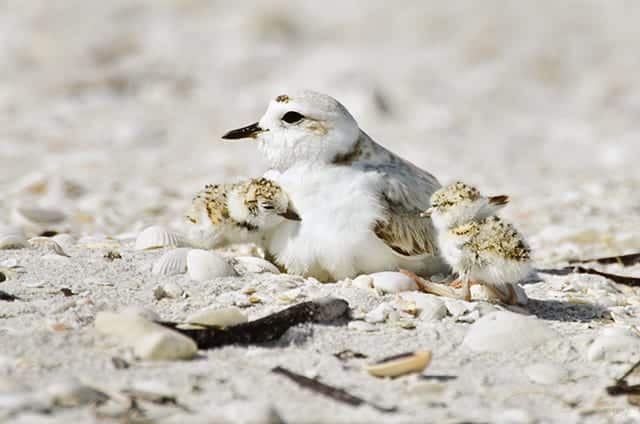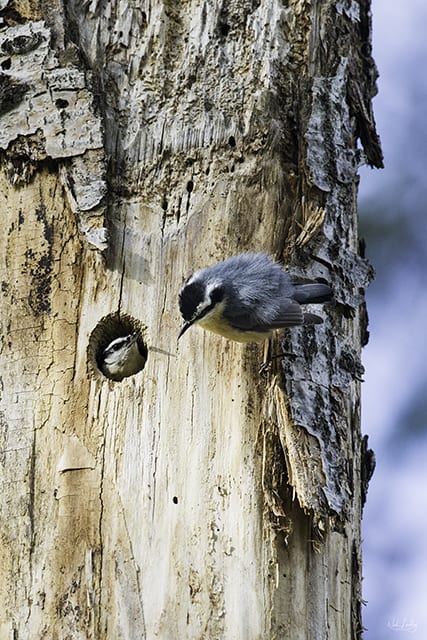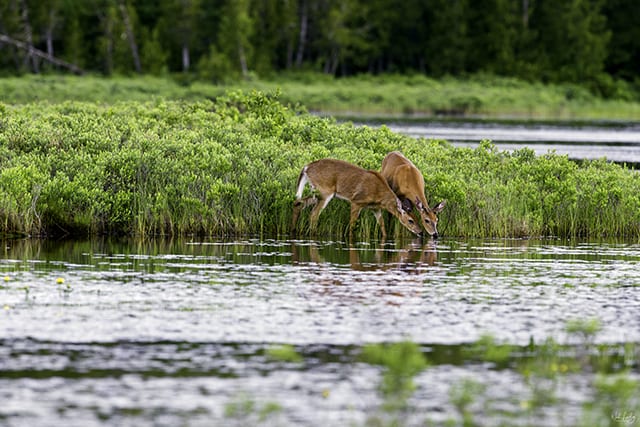
Welcome back to Through the Lens with Nick Leadley, our continuing series on wildlife photography. Read the rest of the series here, and meet Nick in person at the Rangeley Birding Festival, June 7-9.
One question I hear a lot is “How do you get close to your subjects?”
Actually it’s not always a question of me getting close to the bird or animal, but in some cases them coming close to me.
So..back to the question of how does that happen? It starts with a bit of learning and recognizing the behavior of the particular bird or animal you are trying to photograph. And that process starts with researching where to locate what you are looking for. There are an ample number of guide books available that can help you learn the preferred habitat of particular bird or mammal. Of course there is always good old-fashioned observation.
Okay…so I’ve come across a likely spot to find the species I am looking for. What next? In the case of birds I’ll watch them for a while to see if there are particular spots they frequent to feed or sing. Then I’ll find a good vantage point to sit and wait.
To me a good vantage point is one that provides some degree of cover, allows a clear view of the subject and puts the subject in good light with a background that is clean as possible. Another thing to consider in a sit spot is what is behind you…a tangle of tree limbs or brush will help break up your shape. The image of the Red-breasted Nuthatches resulted from a patiently waiting at a sit-spot.

With mammals the “sit spot” approach works well when you can identify what paths or areas the animals use or return to regularly. Game trails and water sources are both good examples. You can never predict what will show up if you sit somewhere regularly used by animals of all types. The photograph of the White-tailed Deer is a good example of an image captured while utilizing a sit spot.

Of course there are times in wildlife photography when cover is not available and you stick out like a sore thumb. Beaches are a prime example…there are certainly not a lot of places to hide. When photographing birds on beaches I prefer the “low and slow” approach. This is where the ground plate I described in an earlier post comes in handy.
In the low and slow approach I’ll start out at a distance where the birds are obviously comfortable with my presence and engaged in natural behavior. After a few minutes I’ll slowly move forward a count of five to ten paces (or crawls) and watch the birds. If they do not move or appear alarmed I’ll wait another two to three minutes before moving again. This gets repeated until I am have reached the spot where I want to be, or where the birds have let me know that I am too close. The low and slow approach was instrumental in getting the photograph of the Snowy Plovers.
Once you have reached the spot where you want to be, remember to keep your hand and head movements small and slow. I also avoid using camera straps. They can get tangled up on things, including you, and any movement of a strap in the wind can alarm your subject.
Of course, the most important rule is to always make sure you’re not too close to your subject. If you see any signs that the animals you’re photographing are uncomfortable or alarmed, back off immediately. Getting a closer shot is never worth doing harm to the animals. Be extra careful when there are creatures on a nest or with young, as they feel extra vulnerable. This is where zoom lenses are so helpful! Though the Snowy Plover image looks like it was taken from a close distance, I was actually 30 feet away laying on the beach (outside of the roped-off area around the nests) and shooting with a 600 mm lens!
A good source of information on how to approach wildlife or learn their patterns is Jon Young’s book What The Robin Knows: How Birds Reveal the Hidden Secrets of the Natural World. Though not written with photographers in mind the book is a wealth of knowledge on how to view wildlife and recognize our impact as we move through nature. After reading it I completely reevaluated my technique to approaching wildlife with the intention of creating stronger images.
Please feel free to contact me through my website, www.touchthewildphotos.com, with comments, questions or requests for future blog posts.
